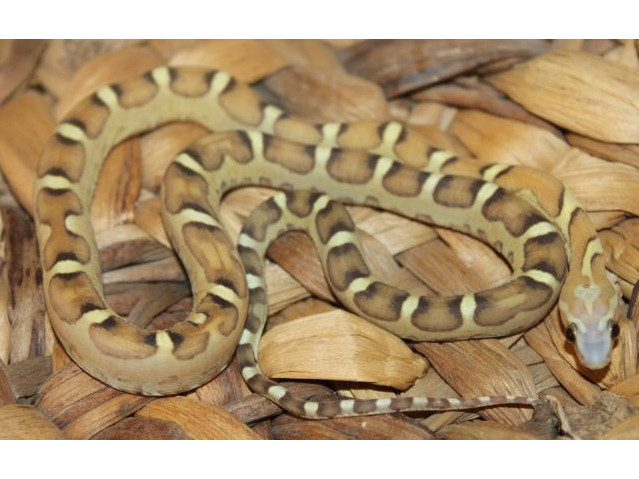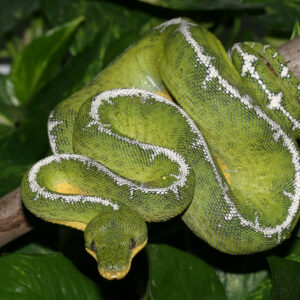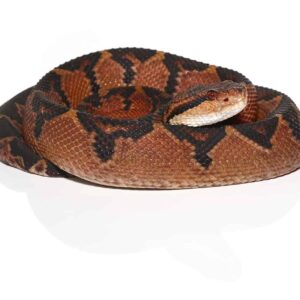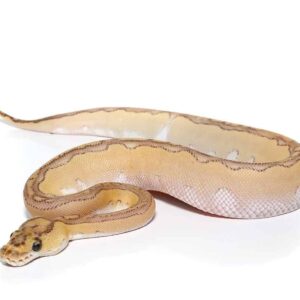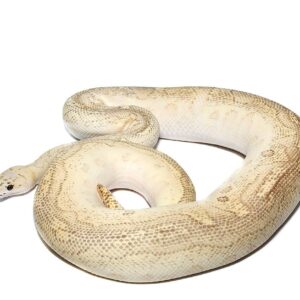Baby Scaleless Het Caramel Cornsnake For sale
$399.99
WE HAVE C.B. BABY SCALELESS HET CARAMEL CORNSNAKES FOR SALE. HERE ARE SOME HIGHLIGHTS:
- Pantherophis guttatus
- Captive Bred
- Approximately 11 – 14 Inches In Length
- Adults Will Grow To 4 – 5 Feet On Average
- Eating Live And Frozen/Thawed Pinky Mice Or Pinky Mice Parts
FUN FACTS!
- This Is A Scaleless Phase Cornsnake. This Classic Is A Great Beginner Pet!
- Easy To Handle, Active And Fun To Watch
- Originating From Eastern North America Ranging From New Jersey, South Florida, Louisiana, And Parts Of Kentucky
- Corn Snakes Are Some Of The Most Widely Dispersed Reptiles In The United States Ranging From A Wide Variety Of Climates And Habitats
- With Good Care These Snakes Can Live Up To 20+ Years In Captivity
Description
The baby scaleless het caramel cornsnake is a fascinating and unique variant within the cornsnake species, captivating reptile enthusiasts with its distinct genetic traits and striking appearance. To fully appreciate the allure of this morph, it is essential to understand the specific genetic characteristics that define it.
The term “scaleless” refers to a genetic mutation where the snake lacks the typical scale covering found on most cornsnakes. This results in a smoother and more delicate skin texture, which, combined with the vibrant colors of the cornsnake, creates a visually stunning reptile. The “het” or heterozygous trait indicates that the snake carries a recessive gene for a particular trait, in this case, the caramel coloration. While the snake itself may not exhibit the caramel color, it can pass this gene to its offspring, potentially producing caramel-colored cornsnakes in future generations.
Caramel cornsnakes are characterized by their warm, golden-brown hues, which add a rich depth to their appearance. This coloration is a result of specific genetic combinations that reduce the presence of melanin, leading to the lighter, caramel-like tones. When these traits are combined—scaleless, het, and caramel—the result is a cornsnake that is not only visually appealing but also genetically intriguing.
The baby scaleless het caramel cornsnake is particularly valued for its unique look and the potential it holds for breeding projects. The smooth, scaleless skin makes it stand out from other morphs, while the heterozygous caramel gene adds an element of surprise and excitement for breeders looking to produce new and interesting color variations. This combination of traits makes the baby scaleless het caramel cornsnake a popular choice among both novice and experienced reptile keepers, contributing to its growing popularity in the herpetological community.
History and Origin
The baby scaleless het caramel cornsnake is a captivating result of meticulous breeding practices, blending the unique scaleless and caramel morphs. The history of these traits traces back to the late 20th century, when reptile enthusiasts began to note and selectively breed for specific genetic variations in cornsnakes (Pantherophis guttatus). The scaleless mutation, characterized by the absence of scales, was first observed in the wild, but it took dedicated breeders to stabilize this trait within captive populations. Renowned breeders such as Don Soderberg played a pivotal role in the early development and propagation of scaleless cornsnakes, refining the genetic lineage to ensure consistent and healthy offspring.
Meanwhile, the caramel morph, recognized for its rich, golden-brown coloration, was also being selectively bred. This morph emerged through the efforts of breeders who aimed to enhance the aesthetic appeal of cornsnakes by isolating and amplifying the caramel coloration gene. The combination of these two distinct traits – scaleless and caramel – was a natural progression in the quest to develop new and visually striking morphs.
The baby scaleless het caramel cornsnake represents a significant milestone in cornsnake breeding. This morph is heterozygous for the caramel trait, meaning it carries one copy of the caramel gene, which can be passed on to its offspring, potentially producing fully caramel-colored progeny when bred with another caramel carrier. Key breeders like Kathy Love and Bill and Kathy Love have contributed extensively to the refinement and popularization of this morph. Their dedication has ensured that these snakes not only exhibit the desired physical traits but also maintain robust health and genetic diversity.
The development of the baby scaleless het caramel cornsnake is a testament to the innovative spirit and perseverance of the herpetological community. Each step in its history highlights the intricate balance of genetics and dedication required to bring such unique and beautiful reptiles into the world. By understanding the origins and evolution of these morphs, enthusiasts can better appreciate the incredible diversity and potential within the realm of cornsnake breeding.
Physical Characteristics
The baby scaleless het caramel cornsnake stands out due to its distinctive appearance, which is largely defined by its lack of scales. This scaleless trait gives the snake a smooth, almost velvety texture, making it visually and tactilely unique among cornsnake morphs. The absence of scales can reveal a more pronounced coloration and patterning, as the underlying skin is more exposed. Typically, these snakes exhibit a striking combination of caramel hues, ranging from light beige to deeper amber tones, interspersed with varying patterns of bands or saddles.
Coloration and patterning can vary due to the genetic combinations present in the scaleless het caramel cornsnake. Some individuals may display more vibrant or distinct patterns, while others might have more subdued or blended appearances. The het caramel gene often enhances the overall color warmth, adding a richer, more golden undertone to the snake’s palette.
Size and growth rates of baby scaleless het caramel cornsnakes are generally consistent with other cornsnake morphs, although there can be slight differences. At birth, these snakes are typically around 8 to 12 inches in length. As they mature, they can reach lengths of 3 to 5 feet, depending on their diet and environmental conditions. Growth rates can vary, but they generally experience rapid growth during their first year, which then slows as they approach adulthood.
Understanding the physical characteristics of the baby scaleless het caramel cornsnake is essential for enthusiasts and breeders. The unique scaleless trait not only affects the snake’s appearance but also requires specific considerations in care and handling. By appreciating these distinctive features, one can better care for and enjoy the beauty of this remarkable cornsnake morph.
Behavior and Temperament
The baby scaleless het caramel cornsnake is known for its intriguing behavior and generally mild temperament, making it a popular choice among reptile enthusiasts. This particular morph exhibits a calm demeanor, which is a significant factor in its suitability as a pet. Unlike some other snake species that may display aggressive or defensive behaviors, the baby scaleless het caramel cornsnake is often docile and tolerant of handling. This trait is especially beneficial for novice snake handlers who are still learning about snake care and handling techniques.
In terms of activity levels, baby scaleless het caramel cornsnakes are moderately active. They tend to be more active during twilight hours, exhibiting crepuscular behavior. This means that they are most active during dawn and dusk, which aligns well with the natural light cycles in a typical household setting. During these times, they can be observed exploring their enclosures, searching for food, or basking under heat sources. Providing a well-structured habitat with hiding spots and climbing opportunities can help mimic their natural environment and encourage healthy activity levels.
Feeding habits of baby scaleless het caramel cornsnakes are generally straightforward. They are carnivorous and primarily feed on appropriately sized rodents. As juveniles, they may require feeding every 5-7 days, with the frequency decreasing as they mature. It’s important to monitor their feeding responses and adjust feeding schedules accordingly. Their willingness to accept pre-killed prey makes feeding less stressful for both the snake and the owner, reducing the risk of injury that can occur with live prey.
Notable behavioral traits of baby scaleless het caramel cornsnakes include their curiosity and adaptability. They are known to adjust well to different environments and handling routines, which further enhances their appeal as pets. Their relatively low maintenance requirements, combined with their gentle nature, make them an excellent choice for both beginners and experienced snake handlers looking to add a unique and visually striking snake to their collection.
Care Requirements
Caring for a baby scaleless het caramel cornsnake involves attention to several specific needs to ensure their health and well-being. These snakes require a carefully controlled environment that mimics their natural habitat. Proper housing is essential; a secure enclosure with dimensions of at least 10-20 gallons is recommended for young snakes, as it provides enough space for movement while being manageable. As the snake grows, a larger enclosure will be necessary.
Maintaining the correct temperature gradient within the enclosure is crucial. The ideal ambient temperature should range between 75-85°F, with a basking spot that reaches up to 90°F. This can be achieved using under-tank heaters or heat lamps. It’s important to monitor the temperature using reliable thermometers to prevent overheating or underheating, which can cause health issues.
Humidity levels should be maintained around 40-60%, which can be managed through regular misting and the inclusion of a water dish. The water dish should be large enough for the snake to soak in, as this helps with shedding and hydration. A hygrometer can aid in monitoring humidity levels accurately.
Choosing the right substrate is also vital. Aspen shavings, cypress mulch, or paper towels are commonly used substrates that provide comfort and are easy to clean. Regular cleaning of the substrate is necessary to prevent the buildup of bacteria and parasites.
Feeding baby scaleless het caramel cornsnakes is straightforward but requires consistency. These snakes thrive on a diet of appropriately sized rodents, such as pinkie mice. Feeding should occur every 5-7 days, with the prey size increasing as the snake grows. It’s important to ensure that the prey is completely thawed and warmed to avoid digestive issues.
Due to their scaleless trait, these cornsnakes may have slightly different care needs. Extra attention should be given to their skin, as they can be more prone to abrasions and dehydration. Monitoring their shedding process is important; providing a moist hide can aid in a successful shed.
By adhering to these detailed care requirements, owners can ensure their baby scaleless het caramel cornsnake thrives in a healthy and comfortable environment.
Health and Common Issues
The baby scaleless het caramel cornsnake, while exhibiting unique aesthetic qualities due to its lack of scales, also faces certain health challenges that owners should be cognizant of. One of the primary concerns is the increased susceptibility to skin infections and injuries. The absence of scales, which typically offer a protective barrier, means that the skin of these snakes is more exposed and vulnerable. Owners need to ensure that the snake’s enclosure is free from sharp objects and rough surfaces that could cause abrasions or cuts.
Additionally, the scaleless condition can sometimes lead to difficulties in shedding. Proper humidity levels in the enclosure are crucial to facilitate smooth shedding processes. A humid hide can be particularly beneficial, providing a moist environment that helps the snake shed its skin more easily. Monitor the snake during shedding periods and assist if necessary, but with caution to avoid causing stress or injury.
Another common health issue that may affect baby scaleless het caramel cornsnakes is respiratory infections. These can stem from improper humidity and temperature regulation within the enclosure. Symptoms to watch for include wheezing, nasal discharge, and lethargy. Regular health checks and maintaining optimal environmental conditions can mitigate these risks. It’s advisable to invest in a reliable hygrometer and thermometer to keep track of the habitat’s conditions accurately.
Owners should also be vigilant for signs of illness such as loss of appetite, weight loss, or abnormal stool. These can be indicators of underlying health issues that require prompt veterinary attention. Regular visits to a reptile-savvy veterinarian are essential to ensure the overall well-being of the baby scaleless het caramel cornsnake.
In summary, while the baby scaleless het caramel cornsnake is a fascinating and visually striking reptile, it necessitates diligent care and monitoring. By understanding and addressing their specific health needs, owners can provide a safe and nurturing environment, ensuring the snake thrives in captivity.
Breeding and Genetics
Breeding baby scaleless het caramel cornsnakes is an endeavor that requires a thorough understanding of genetic principles and careful selection of breeding pairs. The scaleless and caramel traits in cornsnakes are inherited through distinct genetic pathways, and a successful breeding strategy necessitates a blend of both knowledge and patience.
The scaleless trait in cornsnakes is a recessive gene, meaning that both parents must carry the gene for a portion of their offspring to exhibit the scaleless phenotype. Similarly, the caramel trait is also recessive, requiring both parents to possess the gene. When breeding for baby scaleless het caramel cornsnakes, one must ensure that each parent carries both the scaleless and caramel genes, albeit potentially in their heterozygous forms.
To increase the likelihood of producing baby scaleless het caramel cornsnakes, breeders often pair a scaleless caramel snake with a het caramel, or a het scaleless caramel with another het scaleless caramel. This strategic pairing increases the probability of yielding offspring that exhibit the desired traits. For instance, when both parents are het scaleless caramel, there is a 25% chance of producing a scaleless caramel offspring.
Managing the breeding environment is crucial to ensure the health and well-being of both the breeding pairs and the offspring. Optimal conditions include maintaining appropriate temperature gradients, humidity levels, and providing adequate nesting sites for egg deposition. It is also essential to monitor the health and stress levels of the breeding pairs, as stress can significantly impact reproductive success.
Breeding baby scaleless het caramel cornsnakes can present certain challenges, such as genetic variability and the need for precise environmental control. However, the rewards are substantial. Successful breeding can lead to the emergence of visually striking and genetically unique specimens, contributing to the diversity and richness of cornsnake morphs available to enthusiasts and breeders alike.
Conclusion and Resources
In summary, the baby scaleless het caramel cornsnake is a fascinating and unique reptile that appeals to both novice and experienced snake enthusiasts. This guide has explored various aspects of this exceptional breed, including its genetic background, distinct physical appearance, and specific care requirements. The scaleless trait, combined with the caramel mutation, results in a visually striking snake that stands out among other corn snakes. Additionally, the easy-going temperament and manageable size of these snakes make them an excellent choice for pet owners.
For those interested in delving deeper into the world of baby scaleless het caramel cornsnakes, numerous resources are available. Books such as “The Cornsnake Manual” by Bill Love and Kathy Love provide comprehensive care instructions and breeding tips. Websites like CornSnakes.com offer a wealth of information, including care sheets, forums, and community discussions where enthusiasts share their experiences and advice. Additionally, platforms like Reptiles Magazine frequently publish articles and updates about corn snake care and breeding.
Engaging with online forums and communities can also be incredibly beneficial. These platforms provide real-time support and insights from fellow hobbyists and experts. Websites like iHerp and FaunaClassifieds host active forums where questions can be posed, and knowledge can be shared. By participating in these communities, you can stay updated on best practices, emerging trends, and new findings in the field of corn snake care.
We encourage readers to share their experiences and ask questions in the comments section below. Your insights and inquiries are invaluable to the ongoing conversation about caring for and breeding baby scaleless het caramel cornsnakes. By fostering a supportive and informative community, we can collectively enhance our understanding and ensure the well-being of these captivating reptiles.


